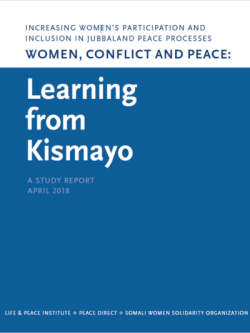Publications & reports
Women, Conflict and Peace
Learning from Kismayo
'Increasing Women’s Participation and Inclusion in Jubbaland Peace Processes: Learning from Kismayo' examines the gendered dynamics of inter-clan conflict in Kismayo, Somalia, and in particular the role of women in processes of violence and peace. The study report forms an exciting contribution to understanding the ways in which violence in Somalia is constructed and promoted, and prompts questions around long-held assumptions on the position of women in relation to this violence. The findings also highlight pathways for practical action to promote greater participation by women in peace processes, both in Somalia and in conflict-affected states more broadly.

- Date
- Type
- Report
- Country/Region
- Somalia
The publication come from the Life & Peace Institute, in partnership with Peace Direct and the Somali Women Solidarity Organization, with the support of the Swedish International Development Agency and the European Union.
The study report is accompanied by a set of ‘Life Stories‘ – deep, introspective narratives provided by six of the individual women that took part in the research. These provide a complementary human grounding to the study.
Summary
The study is undertaken in the city of Kismayo, the administrative capital of Jubbaland Federal State. Situated in Somalia’s most fertile agricultural region, a centre of the charcoal industry and the possible site of gas and oil deposits, Kismayo has been a strategically important commercial centre and seaport since precolonial times. It is the biggest economic hub in South Central Somalia after Mogadishu and one of the largest cities with a current estimated population of 180,300. These factors have made Kismayo the lucrative and highly fought-over target of the warring parties competing for control of revenue and resources in southern Somalia.
Kismayo has experienced some of Somalia’s most intense and longstanding violent conflicts since the collapse of the Siyad Barre government in 1991, and the security and political vacuum that ensued. The nature of the conflict has changed over time – from inter-clan fighting to intense and protracted violent conflict within and between the clan families that have historical claim to the city, moving to more ideologically driven conflict within and between diverse non-state armed groups, including al-Shabaab and clan militias. As such, clan dynamics are not the sole conflict factor, yet over the years they have been ignited and inflamed, fomenting the violent conflicts endured in the city over the past two decades. In one case, clan grievances are said to go back over 200 years – such is the depth of collective memory and grievance yet to be laid to rest through reconciliation.